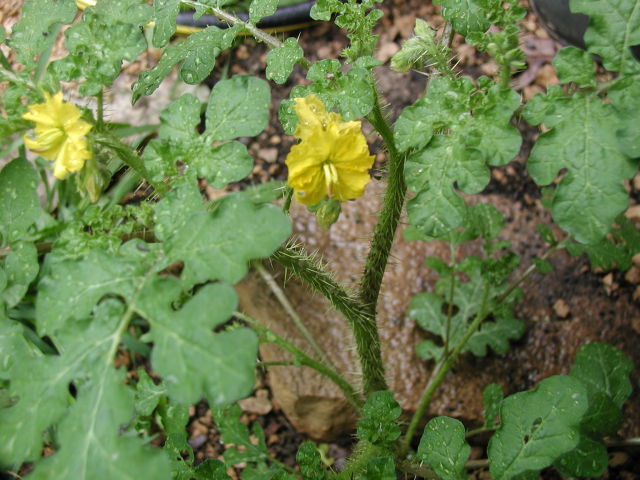Question
 Thistle Plant
Thistle Plant
Sara,
Earlier this season I took pictures of a thistle plant unlike any I've seen. There are "stickers" on both stems and leaves of this plant. I originally thought it may be a Nyjer plant as it sits under a thistle bird feeder, but all attempts to find a photo led to a basic yellow flower only. Because the plant is so unique, I have allowed to to grow and it now has many "pods" along the stems. I am curious to know what it is. It is fascinating to watch its development, but would not want it to spread after this season. The plant is now 3-4' high and 2-3" wide, covered with both flowers and pods.
AnswerYou have Buffalo Bur, Solanum rostratum, also called Prickly Nightshade or Kansas Thistle, which is not actually a thistle but rather a nightshade. It is related to potatoes and tomatoes, but all parts of the plant are poisonous. (Not that anyone would attempt to eat it, as all parts are also thorny!)
It's considered a noxious weed because of the wickedly long thorns. Some people are sensitive to the plant and, when pricked, get a painful dermatitis from it. It also helps spread the Colorado Potato Beetle, a pest of potato crops.
In the fall the entire plant will often break off and roll like tumbleweed, spreading seeds. The pods can break off separately and are painful to step on.
Having said all that, it's an interesting and unusual plant with long-lasting, pretty yellow flowers. I haven't seen it here in NJ, though we have a less-prickly, white-flowered relative called Horsenettle.
I would recommend keeping an eye on it, picking up dropped pods (with gloves on#, and pulling the whole plant in the fall #again with gloves). It does have a taproot, so will be easier to pull after a rain. But in the meantime, why not enjoy it?






